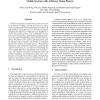Free Online Productivity Tools
i2Speak
i2Symbol
i2OCR
iTex2Img
iWeb2Print
iWeb2Shot
i2Type
iPdf2Split
iPdf2Merge
i2Bopomofo
i2Arabic
i2Style
i2Image
i2PDF
iLatex2Rtf
Sci2ools
CNSR
2007
IEEE
2007
IEEE
Evaluation Framework of Location Privacy of Wireless Mobile Systems with Arbitrary Beam Pattern
Position localization of transmitters can be carried out by an adversary owning a network of pervasive receivers, which can pinpoint the victim mobile nodes’ locations with high temporal and spatial accuracy, such that pseudonym changing and higher-layer obfuscation are insufficient to protect their location privacy. Our contribution is to consider covert beam patterns, generated using multiple antennas to do adaptive beamforming, and so reducing radio signature. We architect such a privacy-enhancing system, give an informal security analysis, and develop an evaluation framework to analyze its location privacy. We performed simulations using wireless LAN parameters, and found that signal-to-noise-ratios for successful direction-finding are more stringent than those required for mere communications. We composed an end-to-end integrated radio and mobility simulation, and compared location privacy performance of omnidirectional versus adaptive beamforming antennas. Our proposal is sh...
| Added | 02 Jun 2010 |
| Updated | 02 Jun 2010 |
| Type | Conference |
| Year | 2007 |
| Where | CNSR |
| Authors | Ford-Long Wong, Min Lin, Shishir Nagaraja, Ian J. Wassell, Frank Stajano |
Comments (0)

